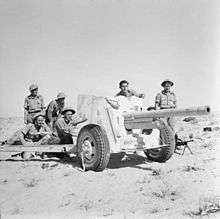7th Support Group (United Kingdom)
The 7th Support Group was a brigade size formation within the British 7th Armoured Division, active during World War II.
| 7th Support Group | |
|---|---|
 | |
| Active | 1938–1942 |
| Country | |
| Branch | |
| Type | Armoured Support Group |
| Role | Armoured Division Support |
| Size | Brigade |
| Part of | 7th Armoured Division (until October 1942) 1st Armoured Division (from October 1942)[1] |
| Nickname(s) | Desert Rats[2] |
| Engagements | Western Desert Campaign |
| Commanders | |
| Notable commanders | William Gott[3][lower-alpha 1] John Campbell Edward Williams |
| Insignia | |
| Identification symbol | Red Desert Jerboa[4] |
| Abbreviation | 7th Sup Gp |
History
The 7th Support Group (or pivot group) provided support for the armoured brigades. It comprised motorised infantry, field artillery, anti-tank guns and light anti-aircraft guns. After the 8th Army was re-organised in preparation for El Alamein, the support group concept was abolished and they were replaced by either a motor brigade or lorried infantry brigade large enough to support the armoured elements.[5]
Commanders
- Brigadier William Gott - Until 3 September 1941
- Brigadier John Campbell - It was when in command of the 7th Support Group that "Jock" Campbell was awarded his Victoria Cross.
Order of battle
Western Desert Force 1939
- 4th Regiment, Royal Horse Artillery
- 1st Kings Royal Rifle Corps
- 2nd Rifle Brigade
Operation Compass
- 4th Regiment, Royal Horse Artillery
- 1st Kings Royal Rifle Corps
- 2nd Rifle Brigade
Order Of Battle - June 1941 (Operation Battleaxe)

- 1st Regiment, Royal Horse Artillery
- 4th Regiment, Royal Horse Artillery
- 1st Kings Royal Rifle Corps
- 2nd Rifle Brigade
Order Of Battle - November 1941 (Operation Crusader)
- 3rd Regiment, Royal Horse Artillery
- 4th Regiment, Royal Horse Artillery
- 1st Kings Royal Rifle Corps
- 2nd Rifle Brigade
- 60th (North Midland) Field Regiment, Royal Artillery
- One Bty, 51st Field Regiment, Royal Artillery
Official VC Citation
War Office 3rd February 1942.
The KING has been graciously pleased to approve the award of the VICTORIA CROSS to Brigadier (acting) John Charles Campbell, DSO, MC (135944), Royal Horse Artillery,
in recognition of most conspicuous gallantry and devotion to duty at Sidi Rezegh on 21st and 22nd November 1941.
On the 21st November Brigadier Campbell was commanding the troops, including one regiment of tanks, in the area of Sidi Rezegh ridge and the aerodrome. His small force holding this important ground was repeatedly attacked by large numbers of tanks and infantry. Wherever the situation was most difficult and the fighting hardest he was to be seen with his forward troops, either on his feet or in his open car. In this car he carried out several reconnaissances for counter-attacks by his tanks, whose senior officers had all become casualties early in the day. Standing in his car with a blue flag, this officer personally formed up tanks under close and intense fire from all natures of enemy weapons.
On the following day, the enemy attacks were intensified and again Brigadier Campbell was always in the forefront of the heaviest fighting, encouraging his troops, staging counter-attacks with his remaining tanks and personally controlling the fire of his guns. On two occasions he himself manned a gun to replace casualties. During the final enemy attack on the 22nd November he was wounded, but continued most actively in the foremost positions, controlling the fire of batteries which inflicted heavy losses on enemy tanks at point-blank range, and finally acted as loader to one of the guns himself.
Throughout these two days, his magnificent example and his utter disregard of personal danger were an inspiration to his men and to all who saw him. His brilliant leadership was the direct cause of the very heavy casualties inflicted on the enemy. In spite of his wound he refused to be evacuated and remained with his command, where his outstanding bravery and consistent determination had a marked effect in maintaining the splendid fighting spirit of those under him.[6]
Notes
- The 7th Support Group was under the command of William Gott during the Italian invasion of Egypt[3]
Footnotes
-
- Paterson, Ian A. "History of the British 7th Armoured Division: 7th Support Group". Archived from the original on 8 February 2004.
- Leakey & Forty 2002, pp. 23–25.
- Playfair 1959, p. 205.
- Leakey & Forty 2002, pp. 102–103.
- Paterson, Ian A. "Regiments That Served With The 7th Armoured Division". Archived from the original on 28 February 2003. Retrieved 8 May 2009.
- "No. 35442". The London Gazette (Supplement). 30 January 1942. p. 545.
References
- Leakey, R.; Forty, G. (2002) [1999]. Leakey's Luck: A Tank Commander with Nine Lives (pbk. ed.). Stroud: Sutton. ISBN 978-0-7509-3195-3.
- Playfair, I. S. O.; et al. (1959) [1954]. Butler, J. R. M. (ed.). The Mediterranean and Middle East: The Early Successes Against Italy (to May 1941). History of the Second World War, United Kingdom Military Series. I. 3rd impression. HMSO. OCLC 888934805.